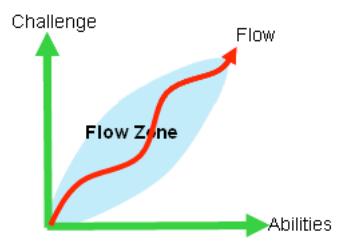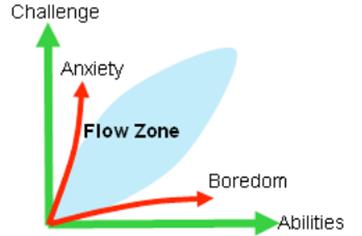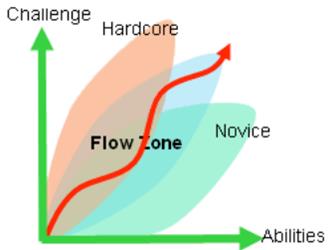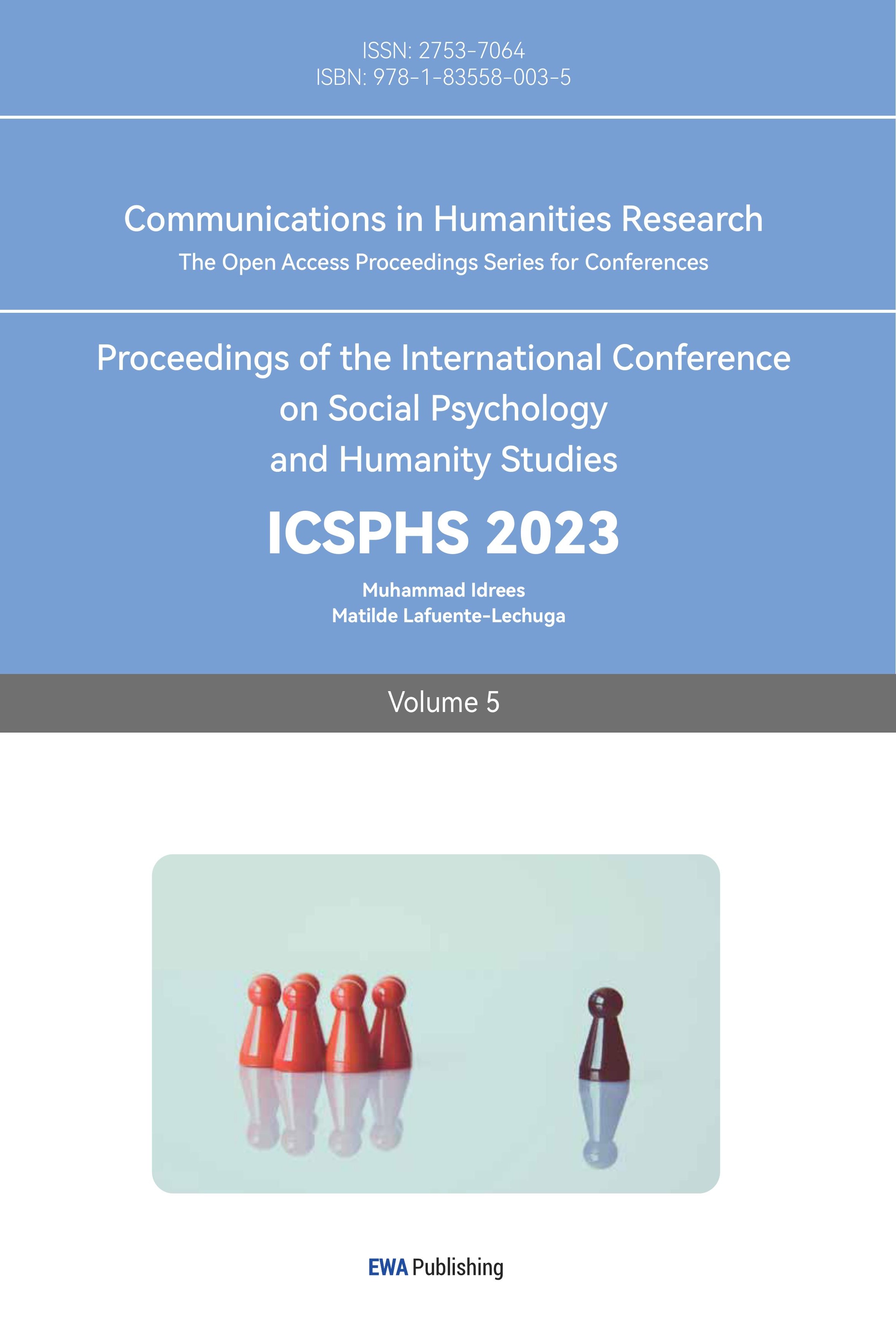1.Introduction
Flow is a psychological concept that is often used in the design of applications and video games. This concept means that the user will go into a state of unawareness, which scales depending on the level of flow that they are in. The author was interested in what factors in video games would have an effect on the flow state for players. Therefore, this paper uses examples from numerous games from varying categories to illustrate the factors and how they function. The point of this paper is to discuss the factors that affect flow in video games.
2.The Concept of Flow
Flow, also known as optimal experience, is a period of time when one feels a strong, deep sense of happiness. This is not achieved by comfort and relaxation, but instead comes from times when a person has to push their body and mind beyond their limits in order to achieve a meaningful goal. These experiences might not seem enjoyable when they just occur, but they add up over time and give one a sense of control over their life. This also means that one has to acquire this by putting effort into realistic goals that are relatively close to what they can handle with their current abilities.
Internal factors are what affect a person's experience the most. “Individuals with a conscious and an a priori willingness to approach a task in pursuit of a specific goal can be described as exhibiting motivational engagement” [1]. “A person can make himself happy, or miserable, regardless of what is actually happening "outside", just by changing the contents of consciousness”. Some individuals could even change a desperate situation into a challenge to overcome using just their minds. This personality is essential for one to enjoy life, as challenging tasks that they have to accomplish will become very enjoyable.
3.Factors That Affect Flow
According to Mihaly Csikszentmihalyi's well-known research, there are seven factors that affect whether the flow state will be achieved [2].
3.1.A Challenging Activity That Requires Skills
Optimal experiences require people to invest in psychological energy, or attention, and skills. However, the skills do not necessarily have to be physical skills, nor do the activities done have to be physical. One of the most popular and enjoyable activities in the world is reading, and it does not require physical skills in order to do it. However, reading is meaningless to those who do not have the skills for it. As one’s skill gets progressed, they will start to look for more suitable tasks. “The rewarding nature of the flow experience motivates individuals to try and replicate it, and this fosters individual growth as - while their skills progress - they seek out more complex challenges” [3].
3.2.The Merging of Action and Awareness
This is the most constantly occurring and distinct feature of flow. When one gets completely absorbed into what they are doing, they will stop thinking about their actions and it will become almost an automatic process. This usually requires great amounts of mental or physical activity in order to be achieved.
3.3.Clear Goals and Direct Feedback
Activities are only enjoyable if one knows how to set goals and get feedback. For activities that are open-ended, it is crucial for the person to set goals for themselves, which sets the framework for feedback. The feedback itself is actually not that important, it only has symbolic value to tell one that they have achieved their goal.
3.4.Concentration on the Task at Hand
When one enters the state of flow, they are able to forget everything that is going on around them and focus entirely on the task. This is one of the most common aspects of flow, and is caused when the activity is so intense that very little information will be let into one’s awareness.
3.5.The Sense of Control
Flow is often described as having control over a task, or, to be precise, not worrying about losing control of the situation. The sensation of control is not pleasurable in and of itself, but the sensation of manipulating control in difficult tasks is. While these experiences can improve one’s mood and give a sense of pleasure, they can also become addictive, where one gets caught in a cycle and will not accept the different possibilities in life.
3.6.The Loss of Self-consciousness
While one is in the state of flow, they tend to forget who they are temporarily, which is commonly inferred as quite enjoyable. During this period, one has the ability to extend themselves beyond who they are. This will lead to the feeling afterwards that one has pushed their boundaries forward.
3.7.The Transformation of Time
Also, one of the most commonly noted factors of flow is that time seems to pass differently while in the flow state. Generally, it feels as if time has slowed down during the experience, but afterward, after one cannot tell where all the time has gone. This is an essential element of optimal experience because it does not have to be for another future benefit, but can stand as a reason by itself.
However, it is not necessary for all seven factors to be achieved for one to trigger optimal experience.
4.Usage of Flow in Games
“Video games form a large and growing segment of the entertainment industry, with estimates placing total revenue for the games industry in 2013 at $21.5 billion USD in the US (ESA, 2014) and €5.8 billion in the UK (Statista, 2014)” [4]. The huge number of gamers also cannot be overlooked. “The number of gamers has reached 2.7 billion in 2020, accounting for more than one-third of the world population, and it is still proliferating” [5]. These two factors are able to hold the expanding video game industry as one of the most influential activity globally. Essentially, all video games can be divided into two sections: game content and game systems. Game content is the core of the video game, and is supposed to convey a meaningful message to the player. The game system is the actual software that uses graphics, positioning, models, sound, narrative, numbers, movement, patterns, language, humor, nature, and more to deliver the game content to the player [6].
Expanding the flow zone is essential to a game’s success. Video games are carefully designed so that they can keep the player within the flow state and increase the chance that they will eventually finish the game. As a result, video game designers will usually construct their game systems so that they are appealing to different players, which will keep them inside the flow zone throughout gameplay.

Figure 1: Illustration showing the basic flow graph [7].
The figure above illustrates what a typical player will actually feel while playing a game. There are some places where the player may feel that the game is a little too easy or hard, but because the flow zone is tolerant enough to keep the player’s experience within it, they will still have an optimal experience during the whole gameplay.

Figure 2: Flow for players experiencing anxiety / boredom [7].
This figure is an example of when the player’s actual experience is led out of the flow zone. This will cause anxiety and stress if the experience has too many challenges, and boredom if the player has too many skills for the challenge level. Either way, they will break out of the flow state.

Figure 3: Different flow zones of hardcore / novice players [7].
Every player has their own understanding of an optimal experience, which makes it very hard for game developers to design a game that suits every player’s needs. For example, the illustration above shows the flow zone for hardcore and novice players, compared to the normal flow zone. Hardcore players prefer harder challenges, so their flow zone will have a steeper slope where the challenge is higher than the player’s skills. In contrast, novice players prefer easier gameplay, so the flow zone’s slope will be flatter, meaning the player has more abilities when faced with a challenge compared to normal. Moreover, players with a specific skill level may have different skill sets, so it will be difficult for them to achieve optimal experience in certain games, eventually turning them away. For example, the beginning of a game requires the player to complete a challenging task that includes lots of shooting. This might come quite easily for a first-person shooter player, but someone who has only played driving games in the past might have a very hard time just passing the beginning. If they still cannot pass after several tries, they might just quit the game, even if the gameplay later on includes plenty of driving. To make up for this disadvantage, the design of a game should enable the player to select their tasks from simple tasks to devastatingly difficult challenges. As a consequence, the flow zone of the game will broaden so that more players from different backgrounds can find tasks that suit them and acquire optimal experience.
Creating a way of adjusting the flow is also crucial to game development. Sometimes, games are too focused on the balance of challenges versus abilities that they forget the importance of making the player feel a sense of control over it. As mentioned before, to expand the flow zone, the game needs to offer a wide variety of choices that the player can choose from. Each player has the chance to make a decision that changes the pace of the game to suit themselves. Once a web of flow-affecting choices is laid out, the game becomes a lot more controllable for the player. If they feel the game is too hard, then they can make a choice to lower the difficulty of their current experience, and vice versa. An issue with the web of choices is that when players have to frequently stop and make a decision, it might affect their optimal experience. A proposed solution is to add a monitoring algorithm to detect whether the player is in the flow state, and only offer choices if they are outside the flow zone. However, there is no system that has the ability to achieve this currently. The only resolution at present is to make the choices embedded, so players can think of them as part of the gameplay and partly ignore the interruptions.
5.Benefits of Using Flow in Games
Usage of the psychology of flow is a necessary part of game development. When used correctly, it can appeal to players of all skill levels and skill sets, allowing the player to achieve optimal experience quickly and throughout the game.
The most essential part of constructing a flow zone within games is to expand the zone with challenges of varying difficulty and insert flow decisions occasionally, letting the player choose their own path to take. In this way, the game would suit a broader range of players, and they would also feel a sense of control over the plot of the game.
A properly used flow structure inside the game can benefit it just as much as a good plot or astounding graphics can. Even if the game seems plain or has mediocre visuals, having a well-designed flow zone can still attract large groups of players to enjoy the game. In the end, a game’s purpose is to entertain the player and convey a meaningful message to them, and these are essential for a decent game to have. Having a flow structure can help game developers easily achieve the first half of a game’s purpose so that they do not need a powerful workforce to craft a plot that leaves the player feeling an overwhelming sense of emotion after playing or graphics that suck their eyes to the computer monitor.
6.Conclusion
Flow is a psychological concept that is often used in the design of applications and video games. This concept means that the user will go into a state of unawareness, which scales depending on the level of flow that they are in. A challenging activity that requires skills, the merging of action and awareness, clear goals and direct feedback, concentration on the task at hand, a sense of control, loss of self-awareness, and the transformation of time are all indicators of flow state. To create a successful flow design, the game needs a flow zone that is tolerant of inflations of experience and choices that affect the skill level in order to appeal to a greater audience. The benefits of this are that more types of players can enjoy the game, and one can make their own decision based on whether they think the game is too hard or too easy, giving them a feeling of control.
References
[1]. Hoffman, Bobby, and Louis Nadelson. (2010). Motivational Engagement and Video Gaming: A Mixed Methods Study. Educational Technology Research and Development, vol. 58, no. 3, pp. 245–270. DOI: 10.1007/s11423-009-9134-9.
[2]. Chen, Jenova. (2007). Flow in Games. Communications of the ACM, vol. 50, no. 4, p. 31. DOI: 10.1145/1232743.1232769.
[3]. Reid, Gavin. (2012). Motivation in Video Games: A Literature Review. The Computer Games Journal, vol. 1, no. 2, pp. 70–81. DOI: 10.1007/bf03395967.
[4]. Soutter, Alistair Raymond Bryce, and Michael Hitchens. (2016). The Relationship between Character Identification and Flow State within Video Games. Computers in Human Behavior, vol. 55, pp. 1030–1038. DOI: 10.1016/j.chb.2015.11.012.
[5]. Zhang, Yongfa, et al. (2022). Influence of Competition-Outcome Feedback in Video Games on Players’ Flow Experience. Current Psychology, 10. DOI: 10.1007/s12144-022-02935-0.
[6]. Starks, Katryna. (2014). Cognitive Behavioral Game Design: A Unified Model for Designing Serious Games.” Frontiers in Psychology, vol. 5, no.28, pp. 1-10. DOI: 10.3389/fpsyg.2014.00028.
[7]. Csikszentmihalyi, Mihaly. (1990).Flow: The Psychology of Optimal Experience. Design Issues, vol. 8, no. 1, p. 80. DOI: 10.2307/1511458.
Cite this article
Huang,R.F. (2023). The Impact of Flow State and Immersion in Video Games. Communications in Humanities Research,5,43-48.
Data availability
The datasets used and/or analyzed during the current study will be available from the authors upon reasonable request.
Disclaimer/Publisher's Note
The statements, opinions and data contained in all publications are solely those of the individual author(s) and contributor(s) and not of EWA Publishing and/or the editor(s). EWA Publishing and/or the editor(s) disclaim responsibility for any injury to people or property resulting from any ideas, methods, instructions or products referred to in the content.
About volume
Volume title: Proceedings of the International Conference on Social Psychology and Humanity Studies
© 2024 by the author(s). Licensee EWA Publishing, Oxford, UK. This article is an open access article distributed under the terms and
conditions of the Creative Commons Attribution (CC BY) license. Authors who
publish this series agree to the following terms:
1. Authors retain copyright and grant the series right of first publication with the work simultaneously licensed under a Creative Commons
Attribution License that allows others to share the work with an acknowledgment of the work's authorship and initial publication in this
series.
2. Authors are able to enter into separate, additional contractual arrangements for the non-exclusive distribution of the series's published
version of the work (e.g., post it to an institutional repository or publish it in a book), with an acknowledgment of its initial
publication in this series.
3. Authors are permitted and encouraged to post their work online (e.g., in institutional repositories or on their website) prior to and
during the submission process, as it can lead to productive exchanges, as well as earlier and greater citation of published work (See
Open access policy for details).
References
[1]. Hoffman, Bobby, and Louis Nadelson. (2010). Motivational Engagement and Video Gaming: A Mixed Methods Study. Educational Technology Research and Development, vol. 58, no. 3, pp. 245–270. DOI: 10.1007/s11423-009-9134-9.
[2]. Chen, Jenova. (2007). Flow in Games. Communications of the ACM, vol. 50, no. 4, p. 31. DOI: 10.1145/1232743.1232769.
[3]. Reid, Gavin. (2012). Motivation in Video Games: A Literature Review. The Computer Games Journal, vol. 1, no. 2, pp. 70–81. DOI: 10.1007/bf03395967.
[4]. Soutter, Alistair Raymond Bryce, and Michael Hitchens. (2016). The Relationship between Character Identification and Flow State within Video Games. Computers in Human Behavior, vol. 55, pp. 1030–1038. DOI: 10.1016/j.chb.2015.11.012.
[5]. Zhang, Yongfa, et al. (2022). Influence of Competition-Outcome Feedback in Video Games on Players’ Flow Experience. Current Psychology, 10. DOI: 10.1007/s12144-022-02935-0.
[6]. Starks, Katryna. (2014). Cognitive Behavioral Game Design: A Unified Model for Designing Serious Games.” Frontiers in Psychology, vol. 5, no.28, pp. 1-10. DOI: 10.3389/fpsyg.2014.00028.
[7]. Csikszentmihalyi, Mihaly. (1990).Flow: The Psychology of Optimal Experience. Design Issues, vol. 8, no. 1, p. 80. DOI: 10.2307/1511458.









